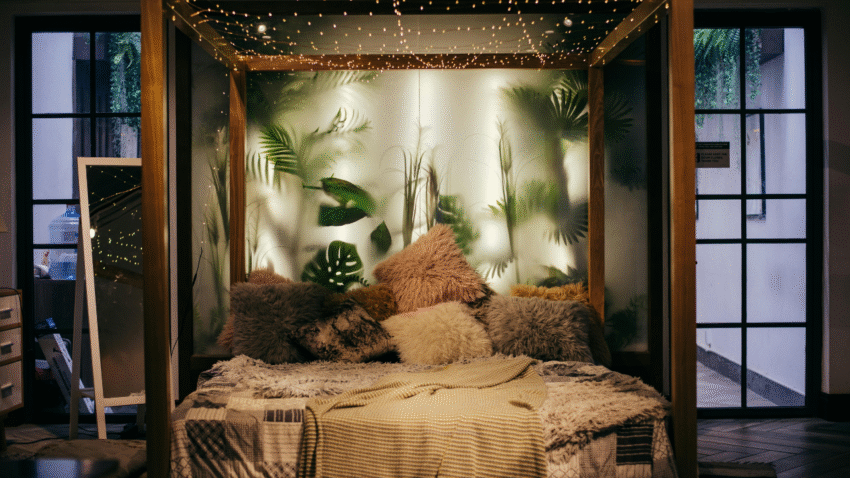Introduction
Struggling to fall asleep, stay asleep, or wake up feeling refreshed? You’re not alone. In our busy, screen-filled world, learning how to create a calming sleep environment is one of the best things you can do for your mind and body. Your bedroom should be a peaceful retreat that signals to your brain it’s time to rest and recharge. This step-by-step guide will show you how to transform your space—so you can drift off faster, sleep deeper, and wake up ready to tackle the day.
Why a Calming Sleep Environment Matters
Good sleep is the foundation for good health, but your surroundings play a huge role. Bright lights, clutter, noise, and uncomfortable bedding can keep you tossing and turning. A calm bedroom environment helps your body relax, lowers stress hormones, and supports your natural sleep cycle. By designing your sleep space intentionally, you’ll fall asleep more easily, sleep longer, and wake up feeling truly restored.
Step-by-Step Guide to Creating a Calming Sleep Environment
1. Declutter Your Bedroom
Visual clutter creates mental clutter.
- Remove items that don’t belong in your sleep space—work papers, unused exercise equipment, or random laundry piles.
- Use baskets, bins, or under-bed storage to keep essentials organized and out of sight.
- Keep surfaces like nightstands and dressers clear except for calming décor or bedtime necessities.
2. Choose a Relaxing Color Palette
Your wall color can affect how calm your bedroom feels.
- Soft, muted shades like light blues, greens, grays, and neutrals promote relaxation.
- Avoid bold, energizing colors like bright reds or neon tones on large walls.
- Use accent colors sparingly with décor, pillows, or blankets to add warmth without overstimulation.
3. Invest in Comfortable Bedding
A comfortable bed is essential for restful sleep.
- Choose a mattress that supports your preferred sleep position and comfort level.
- Use high-quality sheets made of breathable fabrics like cotton or linen.
- Add cozy blankets and pillows that help you feel snug without overheating.
4. Block Out Excess Light
Light can signal to your brain that it’s time to wake up—even at 3 AM.
- Use blackout curtains or shades to block streetlights, headlights, or early morning sun.
- Add a sleep mask if total darkness helps you relax.
- Dim your bedroom lights at least an hour before bed to help your body produce melatonin.
5. Reduce Noise Disruptions
Noise can jolt you awake or prevent deep sleep.
- Use a white noise machine or fan to mask outside sounds.
- Earplugs can help if you live in a noisy neighborhood or have a partner who snores.
- Add soft furnishings like rugs, curtains, or upholstered headboards to absorb sound.
6. Keep Your Bedroom Cool and Comfortable
Your body naturally cools down as you fall asleep.
- The ideal sleep temperature is around 60–67°F (15–19°C).
- Use breathable bedding and sleepwear that suits the season.
- Consider a ceiling fan or portable fan for better airflow if your room tends to get stuffy.
7. Use Calming Scents and Aromatherapy
Soothing scents can signal to your mind that it’s time to unwind.
- Try lavender, chamomile, or sandalwood essential oils in a diffuser.
- Light a calming candle in the evening (blow it out before you fall asleep!).
- Use linen sprays on your sheets and pillows for an extra touch of relaxation.
8. Choose Warm, Soft Lighting
Bright overhead lights trick your brain into staying alert.
- Use bedside lamps with warm bulbs (2700K or lower) for a cozy glow.
- Consider dimmable lights or smart bulbs to gradually reduce brightness before bed.
- Place fairy lights or soft LED strips behind your headboard for a gentle ambiance.
9. Limit Electronics and Screens
Blue light from screens can suppress melatonin, making it harder to fall asleep.
- Keep your phone, tablet, or laptop out of bed—or better yet, out of the bedroom altogether.
- If you use your phone as an alarm, put it across the room so you’re not tempted to scroll.
- Try reading a book, journaling, or meditating instead of screen time before bed.
10. Add Personal Comforts and Rituals
Make your bedroom feel like your sanctuary.
- Add cozy touches like your favorite throw blanket, meaningful artwork, or family photos.
- Play soft, calming music or nature sounds while you get ready for bed.
- Develop a simple nighttime ritual—like sipping herbal tea or doing gentle stretches—to signal it’s time to unwind.
Common Mistakes to Avoid
Mistake 1: Overcrowding Your Space
Solution: Less is more. Keep furniture and décor simple to let your mind rest.
Mistake 2: Using Harsh Lighting
Solution: Switch to warm, dimmable bulbs to keep the atmosphere cozy.
Mistake 3: Skipping Noise Control
Solution: White noise or soft rugs can make a big difference for light sleepers.
Mistake 4: Ignoring Your Mattress and Bedding
Solution: Upgrade bedding as needed—your comfort directly affects your sleep quality.
Mistake 5: Bringing Work Into the Bedroom
Solution: Keep work items and screens out so your brain only associates your bedroom with rest.
Extra Tips & Bedroom Hacks
- Try Natural Sleep Aids: Herbal teas like chamomile or valerian root can help you unwind before bed.
- Keep a Bedside Notebook: Jotting down worries or to-dos can clear your mind and reduce nighttime anxiety.
- Related Guide: Want to sleep even better? Check out our step-by-step article on how to sleep better with blackout curtains to make your room a true sleep haven.
Conclusion
When you know how to create a calming sleep environment, you’re setting yourself up for deeper, more restful sleep every night. From decluttering and cozy bedding to soothing scents and soft lighting, every detail works together to help you drift off peacefully and wake up refreshed.
Remember: your bedroom is your sanctuary—protect it! Bookmark this guide and use it anytime you’re ready to refresh your sleep space and build better bedtime habits. Sweet dreams!
